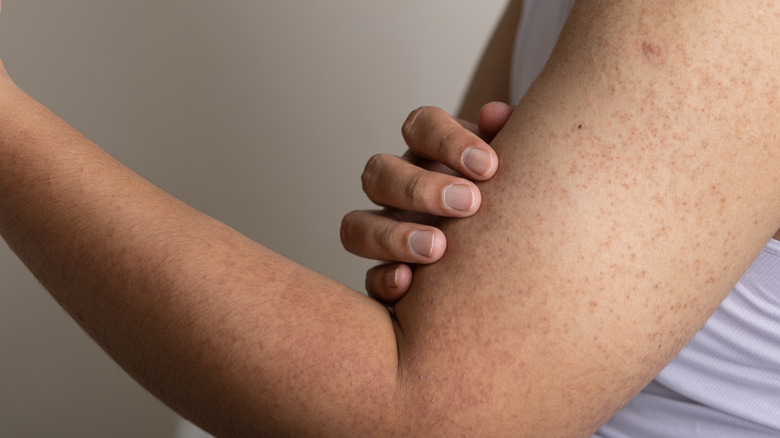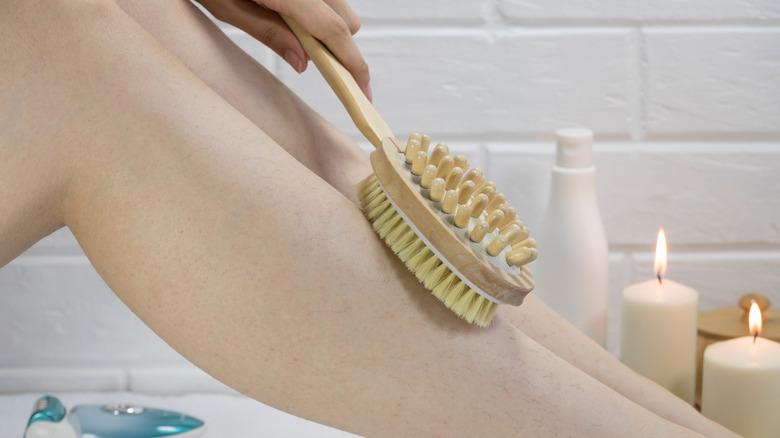If You Have Chicken Skin On Your Neck, You Could Have This
If you've noticed bumpy patches on your neck, you could be dealing with a common skin condition called keratosis pilaris. Nicknamed "chicken skin" because of its texture, this condition usually appears on the upper arms, thighs, cheeks, or buttocks — but it can also show up on the neck, forearms, or lower legs. Basically, anywhere you have hair follicles is fair game.
The bumps associated with keratosis pilaris are composed of excess keratin. They may feel rough in texture and can vary in color depending on skin tone. The skin around the bumps may be discolored, itchy, and dry. Anyone can develop keratosis pilaris. However, it's more common in babies, young children, and teens. This condition is not harmful or contagious and will often go away by the time a person reaches their mid-20s. In most cases, it will have completely cleared by the time a person reaches 30 years of age.
What causes keratosis pilaris
Keratin is the protein that forms your hair, skin, and nails. When keratin fails to flake off properly, pores can become clogged, causing bumps to form.
Predisposing factors that make you more likely to develop keratosis pilaris include fair skin (although all skin tones can have it), eczema, ichthyosis vulgaris, asthma, hypothyroidism, Cushing's syndrome, diabetes, Down syndrome, and obesity. There may also be a genetic link, as you will be more likely to develop keratosis pilaris if another family member also has it.
StatPearls further elucidates the genetics associated with keratosis pilaris, stating that mutations in the protein filaggrin, as well as problems with the Ras signaling cascade, have been linked with this condition. Keratosis pilaris is also often associated with atopic dermatitis, which, along with mutations in the filaggrin gene, supports the idea that this condition might result from abnormal epithelial barrier function.
How keratosis pilaris is treated
The American Academy of Dermatology Association says that a three-part self-help regimen may be all that is needed to control keratosis pilaris. They advise gentle exfoliation with a loofah, buff puff, or rough washcloth to remove dead skin cells, followed by application of a product containing alpha hydroxyl acid, glycolic acid, lactic acid, a retinoid, salicylic acid, or urea to further encourage shedding of dead skin cells. Afterward, be sure to use a moisturizer. You can reapply after bathing or anytime your skin feels dry. Don't exfoliate too aggressively, and take a break for a few days if your skin becomes dry or irritated (here's what happens if you exfoliate too much). If these steps are insufficient, they recommend seeing a dermatologist for further advice.
If you visit a dermatologist, you may be given a prescription steroid cream for a week to 10 days to soothe inflammation, followed by a mixture of urea cream and salicylic acid. Weekly or biweekly treatment with retinoids is another option. If creams fail to help you, there are also minor surgical procedures that your doctor can try. For example, they may use a tiny tool to cut the skin and remove trapped hairs and keratin plugs. Dermabrasion, microdermabrasion, chemical peels, and light or laser therapies may also be used to remove blockages. If you have hyperpigmentation, your dermatologist might also advise the use of creams like hydroquinone, azelaic acid, and kojic acid to fade these areas.


